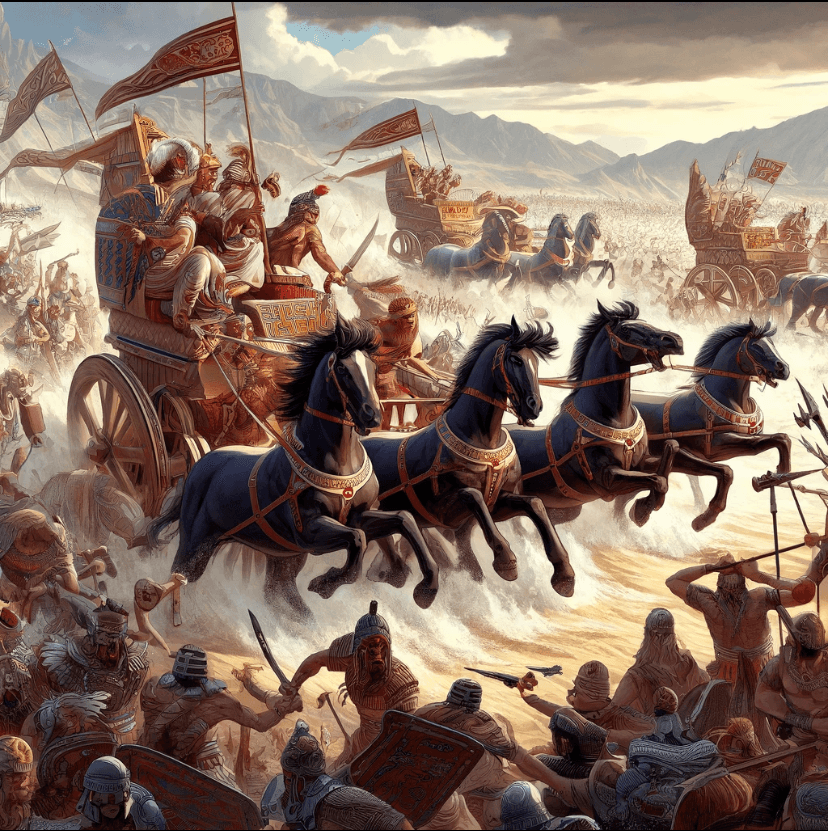"The Battle of Kadesh: The Greatest Conflict of the Ancient World and the First Peace Treaty"

Kadesh: A Trade Hub and Battlefield of the Ancient World
Kadesh was a city located in the region of Syria and known as a significant trade center in the ancient world. The city is famously remembered as the site of the Battle of Kadesh, which took place in 1274 BCE between Pharaoh Ramesses II of Egypt (The Great) and King Muwatalli II of the Hittite Empire.
The History and Importance of the Battle of Kadesh
The Battle of Kadesh is one of the most well-documented military conflicts of the ancient Middle East. Both Egyptian and Hittite sources provide extensive information about this battle. Egyptian accounts, such as the Poem of Pentaur and the Bulletin, describe a great victory for Ramesses II at Kadesh. However, modern historians view these accounts as largely propagandistic and believe the battle ended in a stalemate.
The Background of the Battle
The Hittites had long been a threat to Egyptian territories, causing significant problems during the reign of Pharaoh Thutmose III (1458-1425 BCE). Kadesh was initially captured by the Egyptians under Pharaoh Seti I but was later reclaimed and fortified by the Hittites. Ramesses II decided to launch a major campaign against the Hittites to drive them out of Egyptian borders permanently. One of the key objectives of this campaign was to recapture Kadesh, a vital trade center at the time.
Per-Ramesses and Preparations
Ramesses II ordered the construction of a great city in the Eastern Delta, named Per-Ramesses. This city served both as a palace for entertainment and a military-industrial complex. It housed numerous factories producing weapons, training grounds for men, horses, and chariots, and other industries necessary for military campaigns. In 1275 BCE, Ramesses II prepared his army for the campaign, leading over 20,000 men divided into four divisions: Amun, Re, Ptah, and Set.
The Battle of Kadesh
In his eagerness to confront the enemy, Ramesses II advanced so rapidly that he left the rest of his army behind. He made the mistake of believing reports from two captured Bedouins who claimed that the Hittite king was afraid of the young pharaoh's power and had retreated from the area. In reality, the Hittite army was nearby, and Ramesses II was ambushed.
Two captured Hittite spies later revealed the true situation to Ramesses II, who realized he had no choice but to fight his way out of the trap. The confusion of the battle is evident in Ramesses II's accounts, the Poem of Pentaur, and the Bulletin, which describe how the Amun division was overwhelmed by the Hittites, lines were broken, and the division was scattered. Hittite chariots were cutting down Egyptian infantry, and the survivors were struggling to reach the supposed safety of the Egyptian camp.
Realizing the gravity of the situation, Ramesses II called upon his protective god Amun and reorganized his forces. Egyptologist Margaret Bunson describes how Ramesses II "brought calm and purpose to his small units and began cutting his way through the enemy to reach his southern forces." Through the strength of his character and his position as pharaoh and commander-in-chief, he managed to hold together the remnants of his outnumbered forces.
The Role of the Ptah Division and the Outcome of the Battle
Ramesses II turned the tide of the battle with the arrival of the Ptah division. The Ptah division drove the Hittite forces toward the Orontes River, where many Hittite soldiers drowned. Seizing this advantage, Ramesses II pursued the Hittites off the battlefield and declared a great victory for Egypt. However, Muwatalli II also claimed victory, having retained control of Kadesh.
The Treaty of Kadesh
One of the most significant outcomes of the Battle of Kadesh was the Treaty of Kadesh, signed in 1258 BCE. This treaty is considered the world's first recorded peace treaty, establishing peace between the Hittite and Egyptian empires. Among its terms, it stipulated that "ranked or important individuals who tried to escape punishment for their crimes by fleeing from one territory to the other would be extradited back to their rulers."
The Treaty of Kadesh is recognized as the world's first true peace treaty, setting the groundwork for relations between Egypt and the Hittites until the fall of the Hittite Empire around 1200 BCE. Instead of continuing to fight, the Egyptians and Hittites established trade relations, exchanging technological and agricultural expertise that improved the lives of people in both nations.
Conclusion
Kadesh was a vital trade hub and strategic point in the ancient world. The Battle of Kadesh, fought between Ramesses II and Muwatalli II, is a pivotal event in history. While both sides claimed victory, the battle essentially ended in a stalemate. The Treaty of Kadesh, the first true peace treaty in recorded history, was a direct result of this conflict, fostering peace and cooperation between two great empires.
The events surrounding Kadesh highlight the political and military dynamics of the ancient world. Positioned at the intersection of commerce and military strategy, Kadesh played a crucial role in one of history's most significant battles and in the establishment of a lasting peace.
